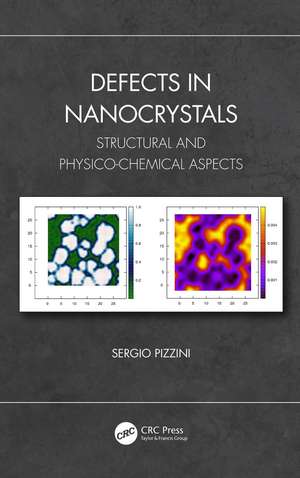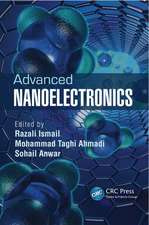Defects in Nanocrystals
Autor Sergio Pizzinien Limba Engleză Paperback – feb 2022
- Outlines the influence of growth processes on their morphology and structure
- Describes the benefits of optical spectroscopies in the understanding of the role and nature of defects in nanostructured semiconductors
- Considers the limits of nanothermodynamics
- Details the critical role of interfaces in nanostructural behavior
- Covers the importance of embedding media in the physico-chemical properties of nanostructured semiconductors
- Explains the negligible role of core point defects vs. surface and interface defects
| Toate formatele și edițiile | Preț | Express |
|---|---|---|
| Paperback (1) | 487.98 lei 6-8 săpt. | |
| CRC Press – feb 2022 | 487.98 lei 6-8 săpt. | |
| Hardback (1) | 1113.95 lei 6-8 săpt. | |
| CRC Press – 28 mai 2020 | 1113.95 lei 6-8 săpt. |
Preț: 487.98 lei
Preț vechi: 574.09 lei
-15% Nou
93.39€ • 97.14$ • 77.10£
Carte tipărită la comandă
Livrare economică 14-28 aprilie
Specificații
ISBN-10: 0367489074
Pagini: 294
Ilustrații: 18 Tables, black and white; 13 Illustrations, color; 161 Illustrations, black and white
Dimensiuni: 156 x 234 x 16 mm
Greutate: 0.42 kg
Ediția:1
Editura: CRC Press
Colecția CRC Press
Cuprins
Notă biografică
Sergio Pizzini is author of more than 250 technical papers published in international Journals. He authored or co-authored four books and was Chairman or Co-Chairman of a number of international symposia in the materials science field. After his retirement, he serves the University of Milano-Bicocca with an external cooperation.
Recenzii
--R. E. Buntrock, independent scholar, CHOICE, June 2021
Descriere
Defects in Nanocrystals: Structural and Physico-Chemical Aspects discusses the nature of semiconductor systems and the effect of the size and shape on their thermodynamic and optoelectronic properties at the mesoscopic and nanoscopic levels. The nanostructures considered in this book are individual nanometric crystallites, nanocrystalline films, and nanowires of which the thermodynamic, structural, and optical properties are discussed in detail. The work:
- Outlines the influence of growth processes on their morphology and structure
- Describes the benefits of optical spectroscopies in the understanding of the role and nature of defects in nanostructured semiconductors
- Considers the limits of nanothermodynamics
- Details the critical role of interfaces in nanostructural behavior
- Covers the importance of embedding media in the physico-chemical properties of nanostructured semiconductors
- Explains the negligible role of core point defects vs. surface and interface defects
Written for researchers, engineers, and those working in the physical and physicochemical sciences, this work comprehensively details the chemical, structural, and optical properties of semiconductor nanostructures for the development of more powerful and efficient devices.












